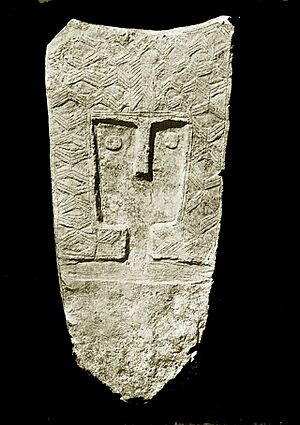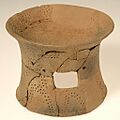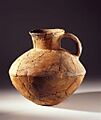Chasséen culture facts for kids
| Geographical range | France |
|---|---|
| Period | Neolithic |
| Dates | 4500–3500 BC |
| Preceded by | Cerny culture |
| Followed by | Seine-Oise-Marne culture, Véraza culture in southern Languedoc, Treilles culture in the Causses, Ferrières culture in eastern Languedoc, and La Couronne culture in Provence |
The Chasséen culture was a group of people who lived in ancient France during the late Neolithic period. This was a time when people started farming and living in settled communities. The Chasséen culture existed roughly between 4500 BC and 3500 BC.
The name "Chasséen" comes from a special place called a type site. This site is near a village called Chassey-le-Camp in France. It's where archaeologists first found many clues about these people.
Where the Chasséens Lived
The Chasséen culture covered a large area of what is now France. This included regions like Occitanie and Provence-Alpes-Côte d'Azur. Their influence also spread north.
They lived across the plains and plateaus of France. This included areas around the Seine river and the upper Loire valleys. Evidence of their settlements has been found in many places. These include modern-day areas like Haute-Saône and Pas-de-Calais.
Archaeologists found an amazing Chasséen village in Bercy, which is now part of Paris. This village existed around 4000 BC to 3800 BC. It was located on the right bank of the Seine river. They discovered many interesting things there. These included wooden canoes, pottery, bows and arrows. They also found tools made from wood and stone.
Daily Life of the Chasséens
The Chasséen people were mostly farmers and herders. They didn't move around much, which means they were "sedentary." They grew different crops like rye, panic grass, and millet. They also cultivated fruits such as apples, pears, and prunes.
For food, they raised animals like sheep and goats. They also had oxen and pigs. These animals provided them with meat, milk, and other resources.
The Chasséens lived in simple huts. These huts were grouped together to form small villages. A typical village might have had between 100 and 400 people. Their pottery was usually plain and didn't have many decorations.
They lived before people started using metal tools. So, they didn't have metal technology. Instead, they were very skilled at using flint. Flint is a hard stone that can be shaped into sharp tools. They used it for cutting, hunting, and other daily tasks.
The End of the Chasséen Culture
Around 3500 BC, the Chasséen culture in France began to change. New cultures started to appear. In Northern France, the Seine-Oise-Marne culture took its place. This new culture lasted from about 3100 BC to 2000 BC.
In Southern France, several other archaeological cultures developed. This shows how different groups of people changed and evolved over time.
Important Dates
Here are some key dates related to the Chasséen culture:
- 4400 BC: A Chasséen village was established at Saint-Michel du Touch near Toulouse.
- 4000 BC: The Chasséen village of Bercy near Paris was active.
- 3530 BC: Chasséen culture was present in the Pas-de-Calais area.
- 3450 BC: The Chasséen culture ended in the Eure-et-Loir region.
- 3400 BC: The Chasséen culture ended in Saint-Mitre in Alpes-de-Haute-Provence.
Images for kids
See also
- Neolithic France
- Cortaillod culture
- Chasséen-Lagozza-Cortaillod culture
- Rössen culture (4500 BC - 4000 BC)
- Funnelbeaker culture (4000 BC -2700 BC)
- Sepulcres de fossa culture (4200 BC - 3600 BC)
- Véraza culture (3400/3300 BC - 2700/2600 BC)
- Seine-Oise-Marne culture (3100BC - 2000 BC)
- Beaker culture (2800 BC - 1900 BC)







